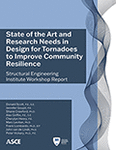Appendix C
Workshop Research Needs Mapped to National Windstorm Impact Reduction Program Elements
Publication: State of the Art and Research Needs in Design for Tornadoes to Improve Community Resilience: Structural Engineering Institute Workshop Report
NIST is the lead agency in the US Federal Government for the NWIRP with the following stated vision and mission (NIST 2017).
The NWIRP Vision is:
A nation that is windstorm-resilient in public safety and economic well-being.
The NWIRP Mission is:
To achieve major measurable reductions in the losses of life and property from windstorms through a coordinated federal effort, in cooperation with other levels of governments, academia, and the private sector. NWIRP will support research aimed at improving the understanding of windstorms and their impacts and develop technical guidance and support outreach initiatives encouraging the implementation of cost-effective mitigation measures to reduce those impacts.
To accomplish the vision and mission NWIRP has established three overarching, long-term strategic goals, which are reproduced as follows. Priority research needs are shown in bold font and brackets to indicate how these needs align with the program goals of NWIRP.
Goal A: Improve the Understanding of Windstorm Processes [Research Need No. 3] and Hazards [Research Needs Nos. 2 and 4];
•
Physics of hurricanes, tornadoes [Research Needs Nos. 2, 3, 5, and 7], thunderstorms and other windstorms
•
Climatology of extreme wind events [Research Needs Nos. 3 and 5]
•
Engineering characteristics of extreme wind events [Research Needs Nos. 2, 5, and 7]
•
Effects of long-term trends in storm patterns on future hazards
•
Probabilistic hazard assessments [Research Need No. 4]
Goal B: Improve the Understanding of Windstorm Impacts on Communities [Research No. Need 1];
•
Specific actions that can reduce impacts of windstorms
•
How windstorm hazards impact communities
•
Response of structures to windstorm hazards [Research Needs Nos. 2, 7, and 9]
•
Tools for risk assessment and loss estimation [Research Need No. 6]
Goal C: Improve Windstorm Resilience of Communities Nationwide [Research No. Need 1]
•
Tools for effective prediction and warning
•
Tools for emergency responders
•
Incentives to encourage mitigation
•
Windstorm resistant building codes and standards [Research Needs Nos. 5, 6, 8, and 10]
•
New materials, products, and systems
In addition to these goals and objectives, NWIRP has identified eight priority focus areas for new enhanced efforts through its strategic planning process. These strategic priorities represent a combination of: (1) long-term research efforts to provide foundational windstorm hazard loss and data and models; (2) opportunities for more rapid windstorm impact reduction, building on existing programs; and (3) crosscutting themes to enhance development of the Nation's human resource base in windstorm hazard mitigation fields. These Priorities, listed below and described in Chapter 3, build on and support elements of all 14 objectives.
SP-1: Develop Baseline Estimates of Loss of Life and Property due to Windstorms
SP-2: Obtain Measurement of Surface Winds and Storm Surge Current and Waves in Severe Storms [Research Needs No. 2, 3, 4, and 5]
SP-3: Develop Publicly Available Databases of Windstorm Hazards and Impacts
SP-4: Develop Performance-Based Design for Windstorm Hazards [Research Need No. 1]
SP-5: Improve Windstorm Resistance of Existing Buildings and Other Structures [Research Need No. 8]
SP-6: Enhance Outreach and Partnerships to Improve Windstorm Preparedness and Hazard Mitigation
SP-7: Enhance and Promote Effective Storm Sheltering Strategies [Research Need No. 10]
SP-8: Develop the Nation's Human Resource Base in Windstorm Hazard Mitigation Fields
References
ASCE. 2022. Minimum design loads and associated criteria for buildings and other structures. ASCE/SEI 7-22. Reston, VA: ASCE.
NIST. 2017. Strategic plan for the National Windstorm Impact Reduction Program. A Report from the National Advisory Committee on Windstorm Impact Reduction. Gaithersburg, MD: NIST.
Information & Authors
Information
Published In

State of the Art and Research Needs in Design for Tornadoes to Improve Community Resilience: Structural Engineering Institute Workshop Report
Pages: 233 - 234
ISBN (Online): 978-0-7844-8582-8
Copyright
© 2024 by the American Society of Civil Engineers.
History
Published online: Sep 23, 2024
ASCE Technical Topics:
Authors
Metrics & Citations
Metrics
Citations
Download citation
If you have the appropriate software installed, you can download article citation data to the citation manager of your choice. Simply select your manager software from the list below and click Download.